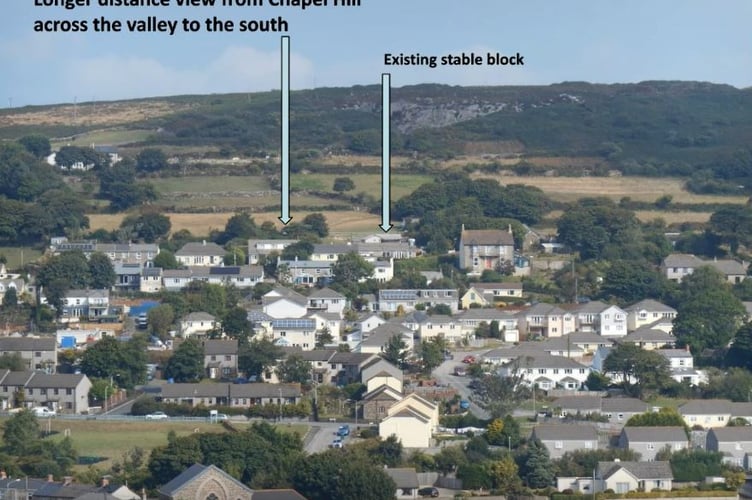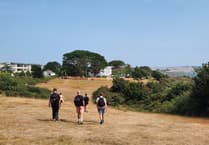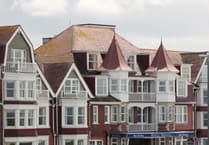A farmer and former Cornwall councillor has been granted approval to build a shelter for horses, hay and machinery on a historic Cornish carn despite the concerns of nearby residents it will harm the area of great landscape value.
Mark Kaczmarek applied to build the field shelter on land to the rear of Trelowena, Pennance Road, Lanner, on the lower slopes of Carn Marth. The granite hill is famous for its historical use as a beacon site and its granite quarries, one of which has been converted into an amphitheatre.
The hill provides panoramic views and is a popular site for hiking and wild swimming, and includes the remnants of prehistoric barrows. It was concerns over the siting and scale of the building in such a location which led local member Cllr John Thomas to call the matter before a Cornwall Council planning committee yesterday (Monday, September 15).
Mr Kaczmarek previously applied to convert and extend an existing domestic stables on the land to a residential dwelling. It was refused in May 2024 following criticism locally, but was allowed on appeal last November.
A council planning officer recommended approval with conditions for what would be a neighbouring field shelter, noting: “While outside the settlement boundary as defined in the Lanner Neighbourhood Plan, such land uses and buildings are considered appropriate in rural areas to support equestrian activities in the countryside.”

However, others were not happy with that. Mark Dunstan spoke on behalf of eight of his neighbours who all object strongly to the proposal. He asked the committee to refuse the application in a bid to stop further erosion of Carn Marth.
Mr Dunstan said the planning officer’s report dismissed local people’s concerns and failed to address key issues. “This site lies on the lower slopes of Carn Marth in an area of great landscape value and outside of the Lanner Neighbourhood Plan. The building will be visible from the carn.
“The applicants have already altered the landscape beyond recognition in the past ten years, with boundary works, groundworks, stables – soon to become a house – a shipping container, a field shelter and lighting. To allow further development here would set a dangerous precedent for the whole hillside.”
He added: “Our homes are immediately below this site. The officer dismissed concerns about noise, smells and nuisance without any evidence. The land is steeply sloping which will make these impacts worse.”
Cllr Tim Luscombe, chairman of planning on Lanner Parish Council, which has unanimously opposed the application, was next to address the meeting.
He said: “This proposal is not a typical field shelter. At 66 square metres, it’s the size of a small bungalow. It raises concerns for potential commercial use and does not meet the principles of the Lanner Neighbourhood Plan.”
He added that development on Carn Marth should be sensitive and small scale. “The proposal is neither. It would harm the neighbouring residents through overshadowing, light pollution, smells, reducing the peaceful enjoyment of their homes and gardens.
“Carn Marth and our community deserve protection from inappropriate development. This application is misleading, disproportionate and harmful.”
Mr Kaczmarek told the committee the building wouldn’t be a stable block but a shelter for hay and implements. He said he had farmed at the site for over 30 years. However, when a farm they used was sold, they lost the use of buildings for storage.
“Having the permission for the stable block [to be turned into a home] gives us the security to live on the land where we can look after the machinery on site, because if you don’t live on site stuff can go missing,” he said, arguing that the field shelter would be a moderate sized building.
“The siting of the building is very well screened – we’ve planted over 200 trees and bushes. It cannot be seen by most of Lanner or by any of the objectors from their buildings.”
Local member Cllr John Thomas said he didn’t believe it would be a moderate size. “It’s been mentioned that the neighbours below can’t see it, but everywhere else you can.”
He added that Carn Marth is part of a group of three carns, with Carnmenellis and Carn Brea, which make up a historic group of land masses, “all forming part of the beacon-lighting celebrations when they occur, which usually should be protected at all costs”.
Committee member and Mayor of Camborne Cllr James Ball said he had concerns about the scale of the building. “It might be hidden but it will still stick out like a sore thumb,” he said, adding that he also had highways concerns as he believed there would be an increase of traffic on the lane leading to the farm.
“I can see the concerns but I think the way it’s been investigated and worked at by our officers and their due diligence gives me confidence to support the application,” said Cllr Mike Thomas, who proposed approval.
Other councillors agreed they didn’t think it would affect the road and would be a suitable building for such use in the countryside. Cllr Ball proposed refusal if approval failed.
The vote to approve was granted with eight for, two against and one abstention.





Comments
This article has no comments yet. Be the first to leave a comment.